- Retour accueil
- Vous êtes ici : Blog Ancient Egypt Atum and the real meaning of snake representations in ancient Egypt ©2022
Atum and the real meaning of snake representations in ancient Egypt ©2022
Publié par Bruno Coursol dans Ancient Egypt le 05/03/2022 à 09:45
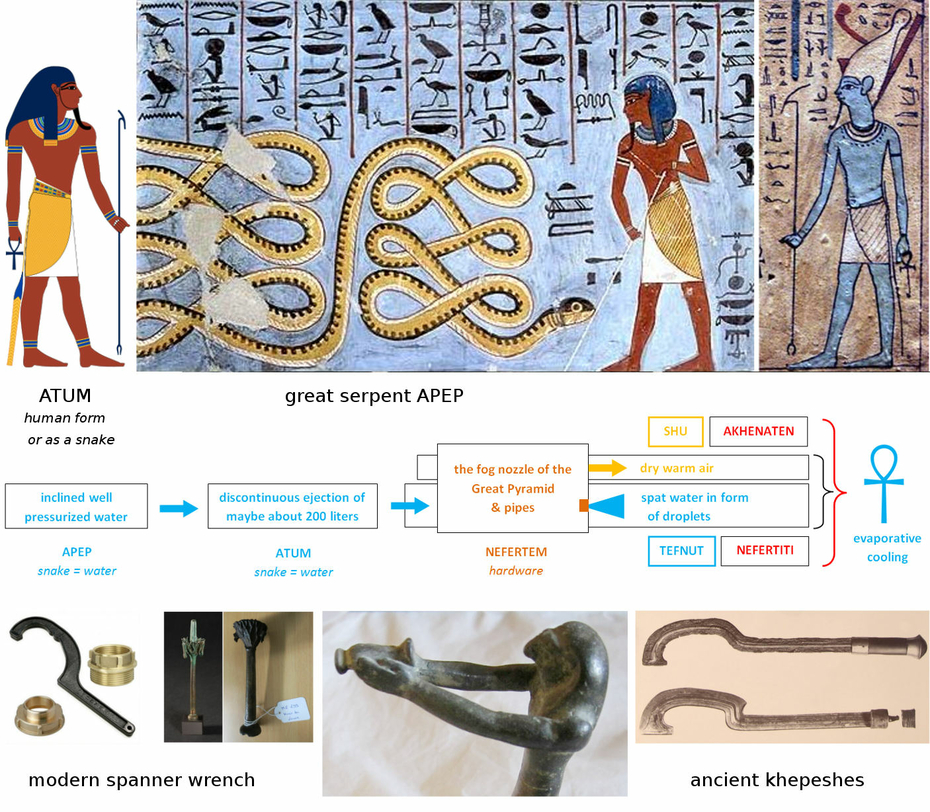
Atum "defeating" Apep, the ancient Egyptian great serpent god of Chaos of the Underworld, as explained by scholars. Atum is also frequently represented as a snake and his real meaning is that he is a portion of Apep. Atum is a metaphor of every buckle of the coiled snake Apep : a small amount of Apep, a portion of its water.
It is the association of dry warm air (personified in god Shu) and spat water in the form of droplets (personified in goddess Tefnut), that is producing the fog of cold in the horizontal passage of the Great Pyramid of Khufu
Center relief from the Tomb of pharaoh Ramses I. Thebes West, near 1307 BC. https://en.wikipedia.org/wiki/Apep#/media/File:Apep_1.jpg
The secret real meaning of Atum defeating Apep : the creation of Atum himself
1 • The theoretical part : "Atum is said to have ascended from chaos-waters with the appearance of a snake."
2 • The illustration : the relief depicting Atum "defeating" Apep, the ancient Egyptian great serpent god of chaos of the Underworld (above photograph), in the Tomb of pharaoh Ramses I, Thebes.
If Atum emerged from chaos waters, and is looking to Apep without doing anything to him (no knife and no blood), what is Atum doing is looking back at himself : Atum is looking at where he is coming from.
Apep is the chaos waters and Atum is made of that water.
This idea that Atum is actually made of water is reinforced by his representation in an human form with the skin painted vivid blue (above right photograph).
Also, it is said that "Atum was […] the first being to emerge from the darkness and endless watery abyss that existed before creation" . "Darkness" and "abyss", would be very appropriate talking about the inclined well, where Atum is coming from.
Atum is the representation of the small amount of pressurized water ejected from the inclined well
Among all gods, Atum really is of great importance, and some would say he is the most important of all, the first creation god as explained by every scholar.
My theory explains why he was so important, why he was seen as the first god of creation.
Just think of "cold production" when you read "creation" in academic articles and everything will come into place : Atum, as the small amount of pressurized water ejected from the waters of the inclined well, was the last step of the process, just before the creation of the cold.
Excerpt from Wikipedia's page on Atum : https://en.wikipedia.org/wiki/Atum
"Atum was a self-created deity, the first being to emerge from the darkness and endless watery abyss that existed before creation. A product of the energy and matter contained in this chaos, he created his children—the first deities, out of loneliness. He produced from his own sneeze, or in some accounts, semen, Shu, the god of air, and Tefnut, the goddess of moisture. The brother and sister, curious about the primeval waters that surrounded them, went to explore the waters and disappeared into the darkness."
Atum had in him, all the energy of the inclined well waters and all the energy of the impactor that constantly rammed into the well. This is only because the small amount of water representing Atum, was under pressure, that the fog of microdroplets could have been created ; hence the reference to the fact that Atum created Shu and Tefnut from his own sneeze or his own semen.
And all that vocabulary, about energy, creation, liquids under pressure and water is present in every description of Atum we can find. The only reason why it doesn't matter that Atum created Shu and Tefnut from his own sneeze or his own semen, is because it is only a metaphor referring to the spray of a liquid under high pressure.

Atum represented in an human form (left) and as a snake in snake coffin artifacts from the Brooklyn Museum : Snake Coffin Accession Number 36.624 (center) and Snake Coffin (Atum) Accession Number 16.600 (right).
Atum ascending from the chaos waters
"In the Book of the Dead, which was still current in the Graeco-Roman period, the sun god Atum is said to have ascended from chaos-waters with the appearance of a snake, the animal renewing itself every morning."
"Early myths state that Atum created the god Shu and goddess Tefnut by spitting them out of his mouth.[…] Other myths state Atum created by masturbation."
Of course, the "chaos waters" are directly referring to the pressurized waters, after they have been hit (rammed) by the fall of the impactor.
The constant reference to the day cycle is a little more tricky to understand : the cycle is not about the Sun, but about the impactor getting in and out of the well. The real cycle is about the operating of the impactor. When it got into the well, it was like going into the night and when it got back into the Grand Gallery, it was like going back into the day, into light (whether it was light from the Sun or from lamps).
Atum, the first creation god, father of Shu and Tefnut, was also represented as a snake
Atum was the first creation god of ancient Egypt and the father of Shu (the god of dry and warm air) and Tefnut (the goddess of spat water and humidity).
During the Amarna period, if Akhenaten and Nefertiti represented themselves precisely in these two particular deities while all the other traditional gods were banished, it is because they wanted to be associated with the creation of the most magical part of the Solvay process : its evaporative cooling.
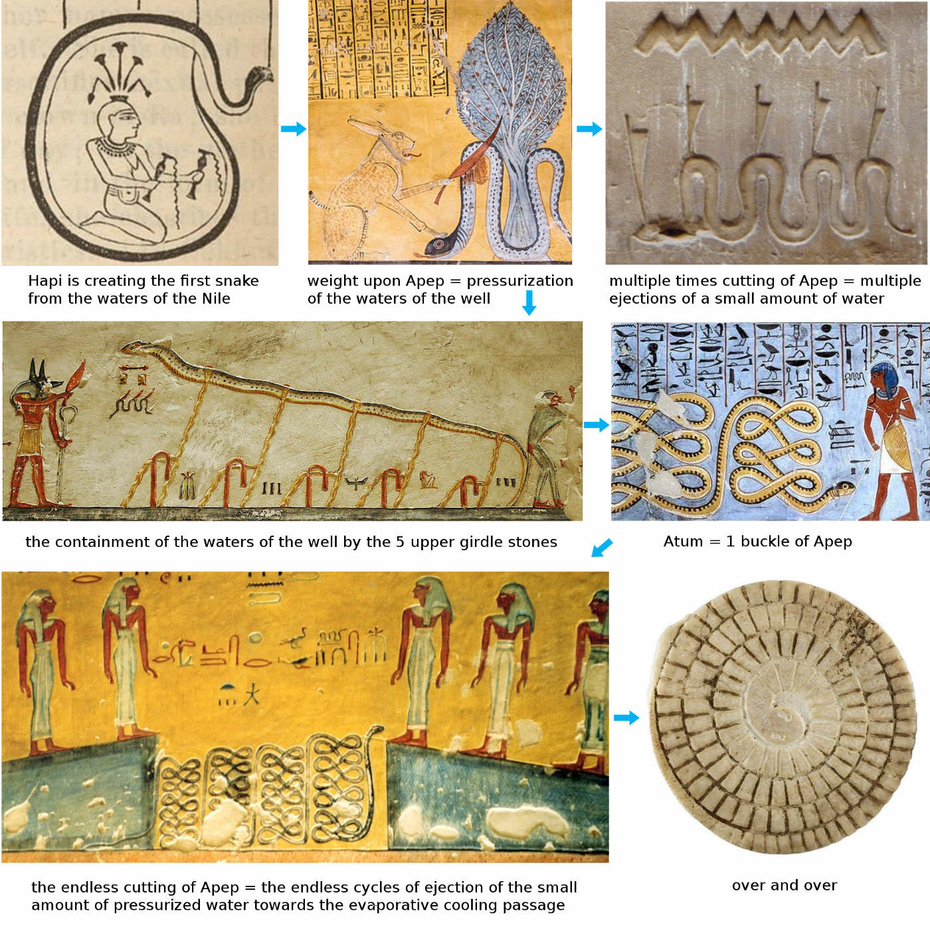
Snake representations of ancient Egyptian gods are about water
One of the most recurrent appearances in ancient Egyptian religion is about snakes : they include the snake in the Hapi's cavern, the great serpent god of the Underworld Apep (Apophis) and the most important of all : Atum.
Additionally to the fact that the waters of the Nile river would exactly look alike a snake from the distance, 3 things can tell us that snakes were representations of water : 1 • Hapi (god of the flood of the Nile) in his cavern, creating a snake with water , 2 • The snakes represented with the "water ripple" hieroglyph as their body, and 3 • The boats moving on snakes
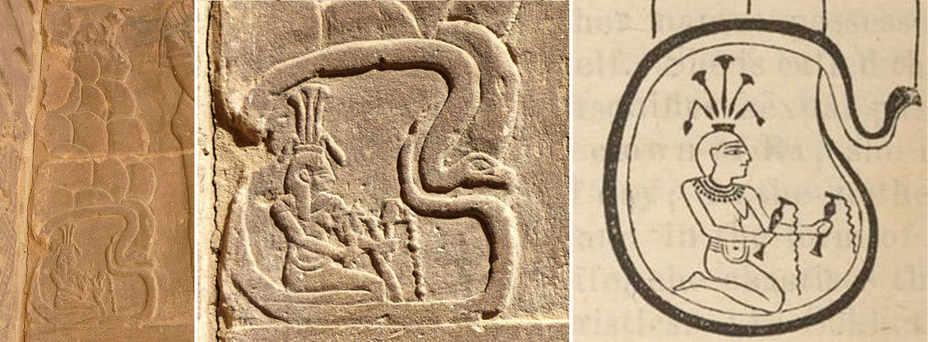
Isis temple, North wall of the Gate of Hadrian with a representation of the Nile god Hapi, crouched in his cave and surrounded by a serpent, Philae, Egypt : https://fr.wikipedia.org/wiki/Fichier:Hapy_Philae.JPG and http://www.temples-egypte.net/philae/hadrien/paroiNord/registreMilieu.html#B1
[Snake = Water] 1 • Hapi in his cavern creating the very first snake out of water
On the left image above (from the Philae temple), Hapi (in his cavern) is depicted creating the very first snake that referred directly to the Great Pyramid. As seen in the previous post, that cavern is a representation of the King's chamber, the main water tank of the pyramid. The fact that Hapi was the god of the annual flood of the Nile, indicates that the water used in the pyramid was coming from the Nile : it wasn't rain water like a first thought it was. It also mean that the pyramid could only have been operated during the flood season.

Wall relief of Apep cut into pieces, temple of Edfu (author : Rémih, on Wikipedia). Serpent artifacts from the Louvre Museum, with the body of the snake taking the shape of the "water ripple" hieroglyph sign. Inventory number E4851. https://collections.louvre.fr/en/ark:/53355/cl010038229
[Snake = Water] 2 • The snake "water ripple" hieroglyph shaped body
The snake artifact E4851 from the Louvre Museum, is showing a unique design : the tail of the snake is nothing else than a continuous succession of "water ripple" signs, clearly highly suggesting that the snake is actually made of water.
Most probably, the "water ripple" sign and the representation of Apep with multiple cuts, as shown on the wall relief left photograph above, together, one above each over, is actually representing the same thing : the "water ripple" sign is the representation of Apep being cut, over and over again.
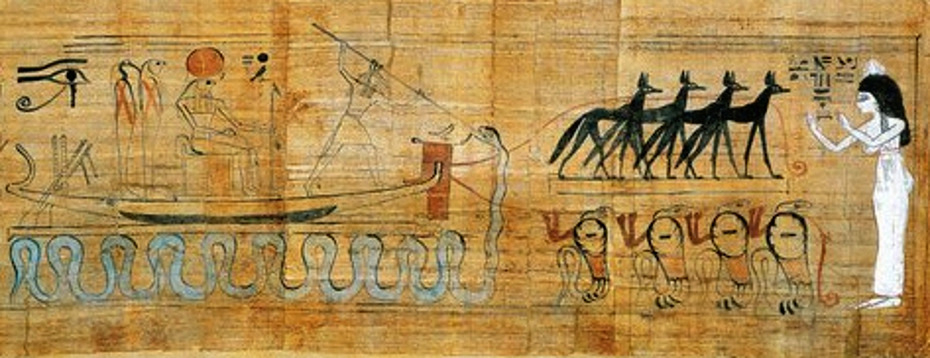
[Snake = Water] 3 • The boats sailing onto snakes
As seen on this representation of Seth attacking Apep, the body of Apep is actually fully supporting the barque. Apep is painted in blue, and his body is also suggesting the waves : the barque is sailing onto the snake representation of Apep.
Conclusion : snakes = water (used to power up the pyramid and coming from the annual flood of the Nile).

[Pressurization of the inclined well] 1 • The Sycamore tree putting its weight upon Apep
I know that the myth about Atum says he is a self-created god, but this part is incorrect : when Atum is represented in front of the great coiled serpent Apep, the real meaning of the scene is about his creation.
Both Apep and Atum are snakes, and both are water metaphors.
Once the waters of the well (represented by Nun, the primordial waters) get hit by the impactor (represented by the Sycomore tree putting its weight upon Apep), the well is pressurized and a small amount of water is ejected towards the horizontal passage and the fog nozzle.
That small amount of pressurized water is Atum.
The misleading puzzle pieces
What is interesting to see, is how hard it is to decipher ancient Egyptian metaphors. For example, the sycamore tree in the first image is clearly put onto the body of the snake : all the weight of the tree is supported by the snake who is totally nailed on the ground.
Of course, the paw of the cat is also reinforcing this idea of putting weight upon Apep. But this is maybe the only time where the tree is so clearly set : most of the time, the sycamore tree is not onto the snake, but just next to it (photograph on the right, above).
Of course, the fact that the sycamore tree isn't onto the snake but just next to it doesn't matter if you know the real story.

Image on the left : the snake god Nehebkau (also spelled Nehebu-Kau), Spell 87 from the Book of The Dead. https://en.wikipedia.org/wiki/Nehebkau. Center : The Spearing of Apep (From the Papyrus of Nekhtu-Amen).
[Pressurization of the inclined well] 2 • The legs onto or under the snake
It is the same kind of association with the legs and the snakes : legs are also referring to the weight that is putting pressure upon snakes (upon water), whether they are onto the snake, or under the snake, like with Nehebkau (above).
It is amazing and fascinating to see that logic can be completely forgotten and different pieces of the puzzle voluntarily misplaced. This treachery obviously has the only intent to give us misleads. The positions of the legs under the snake and the Sycomore tree just next to Apep instead of onto Apep, in many representations are precisely that : misleads.
One could try to decipher the serpent walking on human legs, forever, he'll never understand the trick : the real meaning of the legs are about pressure upon something. Legs should be represented onto the serpent like on the second above image, not the opposite.

Mehen board game photographed by ©Rowan Millar, and posted on flickr : https://www.flickr.com/photos/126337530@N04/28294095688
Atum in front of the coiled serpent Apep : Apep has already been cut multiple times
As we can see on the above image, the character "defeating" Apep is Atum.
This scene is very important because it shows the continuity between these two characters : Atum is actually coming from Apep : Atum is the small amount of pressurized water ejected out of the inclined well by the fall of the impactor.
The first thing to note on the scene where Atum stands in front of Apep, is that Atum doesn't have any knife : Atum is not killing or cutting the snake. Actually, Apep is already cut. That is the meaning of the coils of the serpent : each buckle represent a cycle of water pressurization and ejection, and Atum is a representation of each of these buckles.
The Mehen artifacts, showing a snake that has been cut multiple times in equal size portions, are exactly describing that part of the real explanation of the myth about Apep and Atum.

Wall relief of Apep cut into pieces, temple of Edfu (author : Rémih, on Wikipedia). Ancient Egyptian Mehen board games, showing coiled snakes cut into equal size pieces.
The Mehen game boards are representations of the Great Serpent Apep cut into equal size pieces
This multiple times cutting of the Great Serpent Apep into equal length pieces, is exactly what is depicting the famous ancient Egyptian Mehen board game.
Wikipedia : "Mehen is a board game which was played in ancient Egypt. The game was named in reference to Mehen, a snake deity in ancient Egyptian religion."
The link between Mehen artifacts and Apep cutting : water distribution
1 • The Ballas Mehen was found covering a pot…
Following excerpts are from : Ancient Egyptians at Play, Board Games across Borders. Walter Crist, Anne-Elizabeth Dunn-Vaturi , Alex de Voogt (Bloomsbury Egyptology)
"Of the few boards that have good archaeological provenance, the oldest comes from the late Naqada Tomb 19 at Ballas, now in the Ashmolean Museum (Petrie & Quibell 1896: 42), and dates to the end of the fourth millennium BCE (Rothöhler 1999: 11). Found covering a pot, it was likely a votive representation of a mehen board rather than one used for play, since it was only 10.5 cm in diameter (Kendall 2007: 37), but appears in the form of other full-sized game boards."
2 • And another one was most certainly also a jar lid
"Another mehen game without provenance, now in a private collection, may have been a jar lid much like the Ballas game as it is only 4.5 cm in diameter and unlikely to have been used for play considering it contains 336 very small spaces (Kendall 2007: 37). It depicts a coiled serpent, with a tail and head, much like the others already discussed, but with an important distinction: four holes* were drilled on different parts of the serpent and may have been filled with a colored paste or some kind of inlay, distinguishing those spaces from the others (Kendall 2007: 37)."
*Unfortunately, no picture of this particular Mehen artifact is available ; probably the position of these 4 additional holes could be of some interest.
Were any of the Mehen artifacts designed as game boards?
What we know for sure, is that some of the Mehen board games hadn't been designed to be played with, whether because they are too small, the segments too tiny, or for both of these reasons.
The question is : were any of the Mehen artifacts designed as game boards?

The Great Pyramid of Giza, as a Solvay-like process unit with evaporative cooling for sodium carbonate (natron) and sodium bicarbonate manufacturing.
Ancient Egyptian gods were representations of ancient Egyptians themselves
The most disturbing part of my theory about ancient Egypt, is not the fact that the Great Pyramid of Giza was a sodium carbonate (natron) chemical manufacturing unit that needed to be cooled down by the evaporative power of water, but the fact that every single god worshiped in the temples, were actually representations of the engineering they developed to master this process.
We've already seen that ancient Egyptian gods can be divided into a few groups, depending of the location of the element they are referring to, in the pyramid :
1 • gods referring to the grand gallery : Aker and the Akeru (the axle beam and its support), Sokar (the latch-bolts), etc.
2 • gods referring to the inclined well : Nun (the primeval still waters), Apep (the pressurized waters), etc.
3 • gods referring to the horizontal cooling passage : Atum (the small amount of pressurized water ejected from the well), Nefertem (the high pressure resistant pipe and the fog nozzle), Shu (dry warm air), Tefnut (spat water in form of droplets), etc.
All these gods are referring to the Lower Pyramid, that is the part we know of today, but other gods are referring to the Upper Pyramid were the Solvay process unit was set : Horus, Seth, etc.
Chances are that this Upper Pyramid part is actually the ScanPyramids' Big Void.
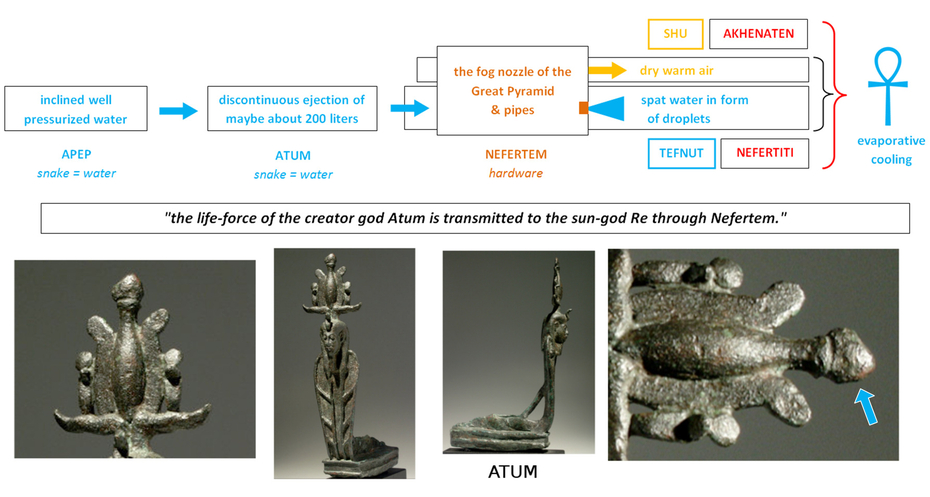
Images of creator god Atum as a snake, E0611 © Alexander Ancient Art : https://www.alexanderancientart.com/611.php
On the Alexander Ancient Art artifact E0611, we can note that Atum is wearing a crown with ram's horns (representing the ramming of the well by the impactor), as well as the fog nozzle itself, from which the fog of microdroplets is most probably starting (blue arrow).
Nefertem 'nfr-tm' is related to Atum 'tm'
As everybody knows, ancient Egyptian literature doesn't use vowels (or we are just completely unable to decipher them).
For example Nefertem is only a modern hypothetical construction of the original name spelled nfr-tm. In the same way, the god known today as Atum was actually named tm.
It means, or suggests that Atum 'tm' is actually a particular aspect of Nefertem 'nfr-tm' :
"In Egyptian mythology, Nefertem (also Nefertum, Nefer-Tem, Nefer-Temu) was originally just the young Atum (his name means beautiful Atum, i.e. youthful Atum), at the creation of the world, who had arisen from the primal waters, in the Ennead cosmogeny."
https://academickids.com/encyclopedia/index.php/Nefertem
Nefertem : the ancient Egyptian god of the lotus flower blossom
"Nefertem (Nefertum, Nefertemu) was the ancient Egyptian god of the lotus flower blossom who emerged from the primeval waters at the beginning of time, and a god of perfume and aromatherapy. He may have originally been considered to be an aspect of Atum."
"According to one version of the creation story of the Ennead in Heliopolis, Nefertum (translated as beautiful Atum, or perfect Atum) was born from a blue lotus flower bud which emerged from the waters of Nun at the beginning of creation."
Adapted from https://ancientegyptonline.co.uk/nefertum/
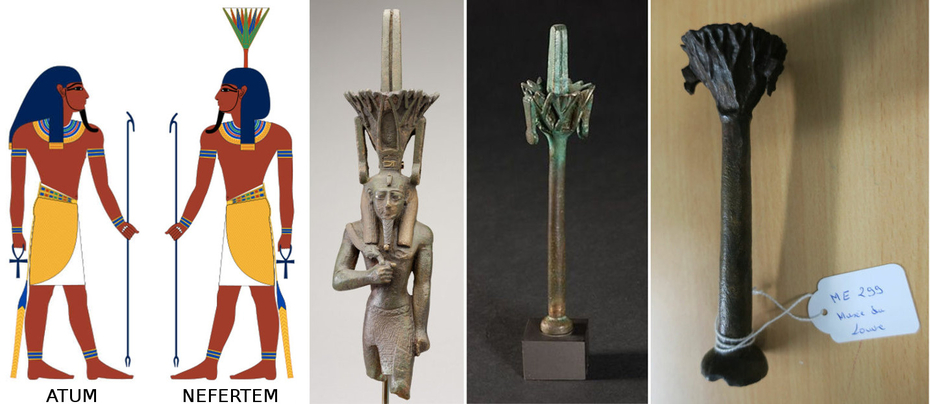
Right : Nefertem emblems from the Louvre Museum : inventory number N 5118 © Musée du Louvre / Christian Décamps : https://collections.louvre.fr/ark:/53355/cl010008518 and ME299 © Musée du Louvre : https://collections.louvre.fr/ark:/53355/cl010337234
Atum passing through Nefertem : the "life force of the creator god Atum transmitted through Nefertem" reference
What I'm saying is that Atum was a representation of the pressurized water ejected from the inclined well, and that it was transformed on the lower platform of the grand gallery into a fog of microdroplets of liquid water inside the horizontal passage. For that to happen, a pipe had to be set on that platform, as well as a fog nozzle.
I'm also saying that these two pieces of hardware were represented into Nefertem's emblems : a pipe and a lotus flower. The lotus blossom being the fog nozzle.
In other words, we can say that Atum (the water) was passing through Nefertem (the hardware).
Amazingly, this idea of Atum passing through Nefertem is already well known :
Excerpt from Michael J. Masley : "Meeks points out that the relationship between the sun and the lotus-Nefertem is well attested in the Pyramid Texts but the birth of the sun-god in the lotus blossom is known only after the Amarna period. Pyramid Texts Spell 249 (Pyr. § 266a): xa (wnjs)| m nfr-tm m zSSn r Srt ra “Unis will appear as Nefertem, as the lotus at the sun-god’s nose” corresponds to the image of the Egyptian deities giving life (anx) to the nose of the king and thus the life-force of the creator god Atum is transmitted to the sun-god Re through Nefertem. As such, Nefertem is a mediator that connects the two great gods."
https://www.facebook.com/groups/619881488204420/permalink/639962346196334/
I've highlighted in bold the important parts of the above text that allows us to understand the fine relation that exists between Nefertem and Atum : they are both connected to the cold production but each one is a very particular aspect of it.
We need to keep in mind that all the efforts on the evaporative cooling, were for one reason only : the chemical "magical" manufacturing of sodium carbonate, the natron that would be used for the mummification of the pharaoh ; hence the reference to the "life-force" and Sun god Re.
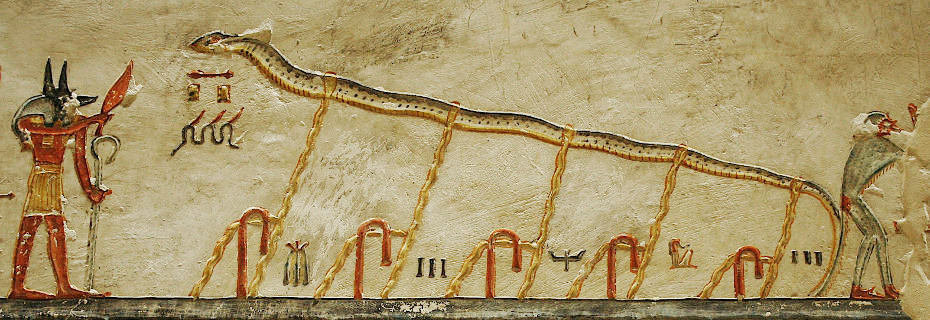
The restraining of Apep relief scene from Ramesses KV19 tomb is representing the birth of Atum : the ejection of the pressurized water out of the inclined well.
The restraining of Apep : the containment of the inclined well pressurized waters
We've seen that the Great Serpent Apep was a metaphor of the inclined well waters and that the fall of the impactor into the well pressurized it. The forces at play were so high that not only it was at the origin of some of the more impressive parts of the fights between Ra and Apep (the thunder noises, the rumble and trembling, etc.), but it also put the well on tremendous structural forces. That was the mission of the girdle stones : maintain the structural integrity of the well.
So, when we are looking at the restraint of the Great Serpent Apep, on the above image from Ramesses KV19 tomb, we are looking at the representation of the water that was restrained inside the well. The ropes are representations of the restraint, and the red elements in a inverted U shape, are the girdle stones : the upper girdles are actually 2 U-shaped half girdles stacked on top of each other.
Apep worship : a gradual process of dismemberment and disposal after putting pressure upon Apep
From Wikipedia : "In an annual rite called the Banishing of Chaos, priests would build an effigy of Apep that was thought to contain all of the evil and darkness in Egypt, and burn it to protect everyone from Apep's evil for another year. The Egyptian priests had a detailed guide to fighting Apep, referred to as The Books of Overthrowing Apep (or the Book of Apophis, in Greek)."
"The chapters described a gradual process of dismemberment and disposal, and include : Spitting Upon Apep / Defiling Apep with the Left Foot / Taking a Lance to Smite Apep / Fettering Apep / Taking a Knife to Smite Apep / Putting Fire Upon Apep".
My interpretation is that the rituals practiced by the worshippers of Apep, once a year, were reproducing the operating cycles of the inclined well pressurization : it started with giving water to Apep (the "Spitting upon Apep"), then putting him under pressure, like with the sycamore metaphor on the Tomb of Inherkau TT359 ("Defiling Apep with the left foot"), then restraining him ("Fettering Apep") and finally watching him cut into tiny pieces in the form of flying sparks as a metaphor of the small amount of pressurized water ejected from the well on every cycle ("Putting fire Upon Apep").
Also, the rituals are described as "a gradual process of dismemberment and disposal".

All the posts on the theory of an ancient Egyptian chemical manufacturing quest, and how an entire religion was built to worship and glorify this human, scientific and technological accomplishment : click on "LE BLOG" button

The impactor of the inclined well
The wooden base of the Ptah-Sokar-Osiris figures
The operating of the grand gallery / The wooden beetle gantry scarab
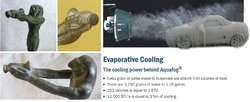
The fog nozzle of the evaporative cooling passage in the Great Pyramid
Horus represented holding the fog nozzle that transformed the pressurized water of the inclined well into a fog of microdroplets, after it had been hit (rammed) by the impactor of the Grand Gallery
Pharaohs represented holding the 2 final products of the Solvay process
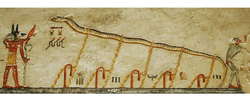
The Great Serpent Apep (Apophis)
The pressurization of the Well / The restraint of the inclined well waters / The 14 Girdle Stones of the Inclined Well
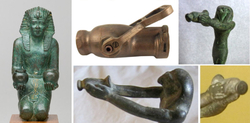
The fog nozzle of the evaporative cooling passage in the Great Pyramid
Horus represented holding the fog nozzle that transformed the pressurized water of the inclined well into a fog of microdroplets, after it had been hit (rammed) by the impactor of the Grand Gallery
Pharaohs represented holding the 2 final products of the Solvay process
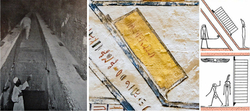
The secret Hauling cavern of the Underworld : the Grand Gallery
The latchbolt representation by Sokar
The axle beam representation by Aker on the Grand Gallery's top platform
The grasp of the Akeru
Poster un commentaire

